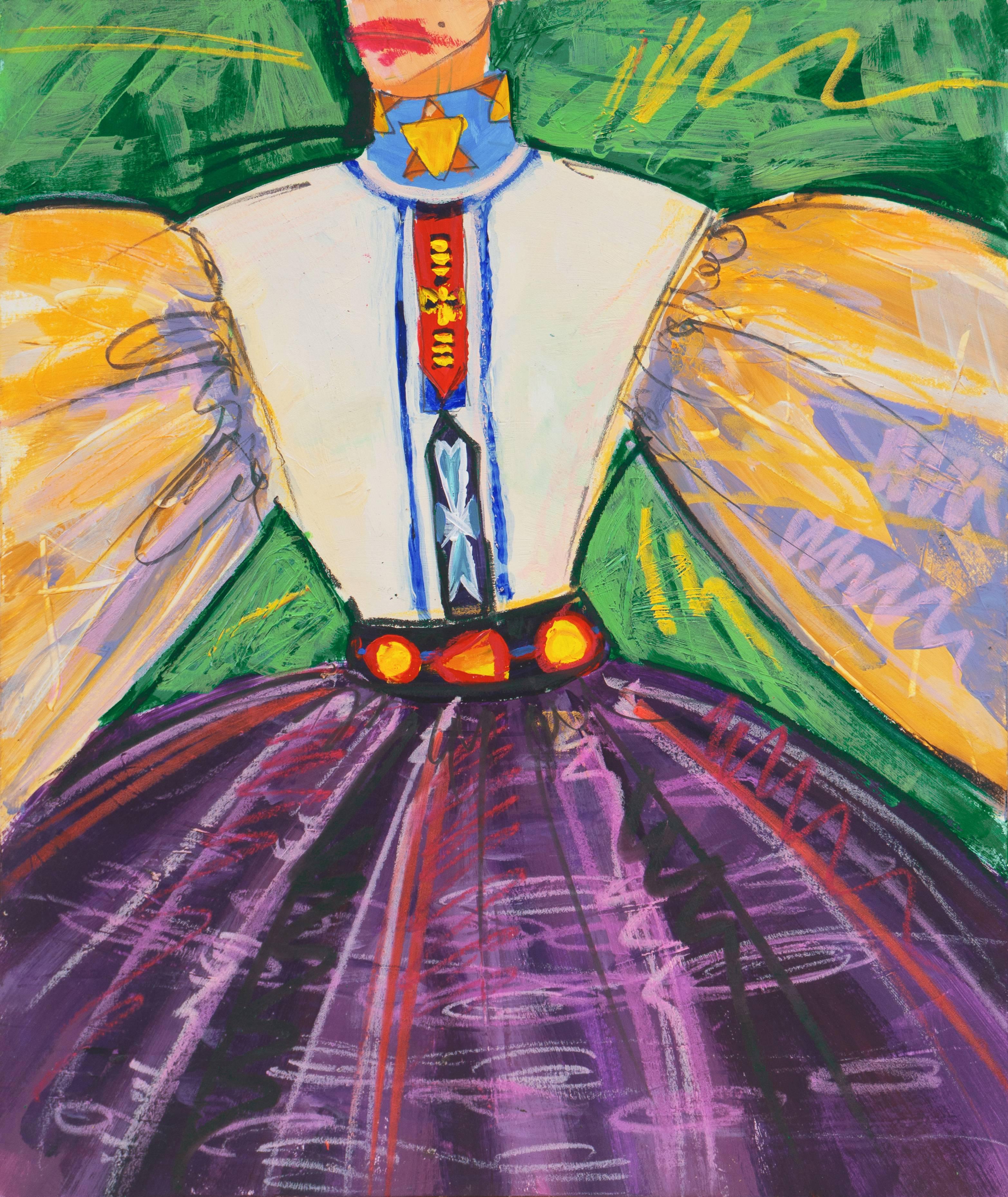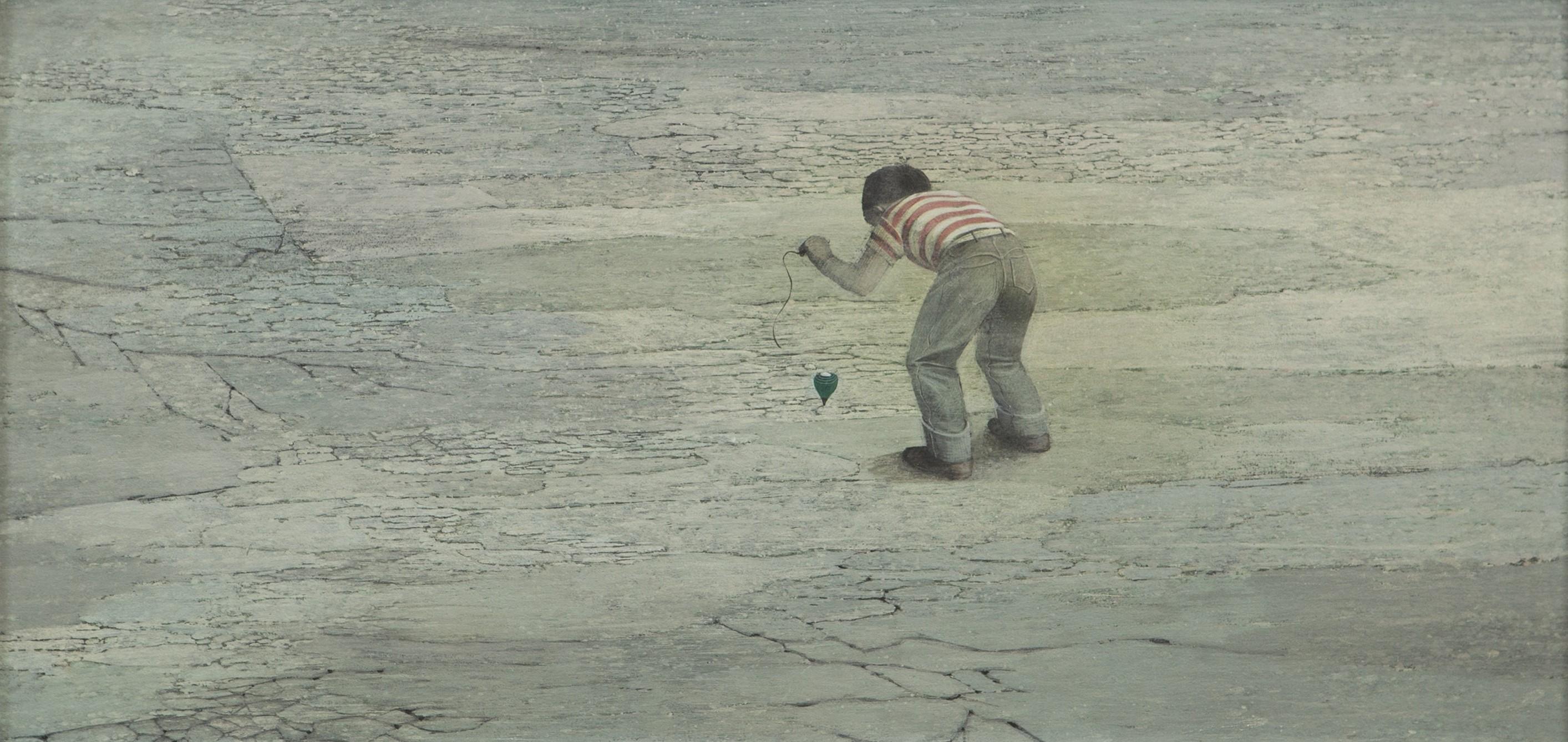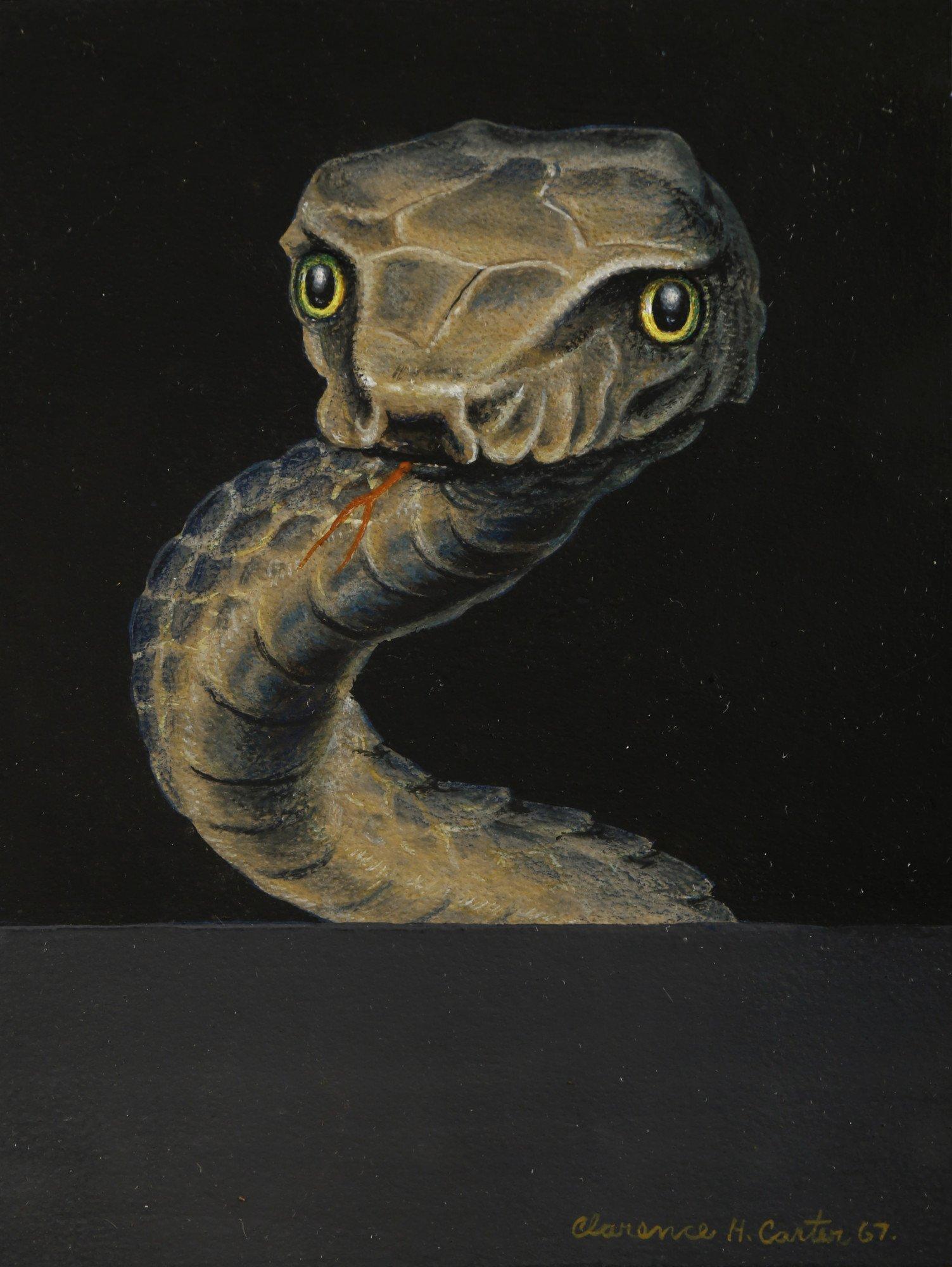Items Similar to Portrait of a Man in Profile Smoking a Pipe, Orange, Blue, Brown, Gray
Video Loading
Want more images or videos?
Request additional images or videos from the seller
1 of 15
Margo HoffPortrait of a Man in Profile Smoking a Pipe, Orange, Blue, Brown, Gray
About the Item
Vintage original painting by 20th century Chicago/Manhattan woman artist, Margo Hoff. The untitled painting is of an older man with gray hair shown in profile with an orange background. The man bears a resemblance to Norman Rockwell and is wearing a flannel shirt, a blue baseball cap and is smoking a pipe. The painting likely dates to the 1950s, 1960s or 1970s. Painted in acrylic, casein, and graphite on masonite board. Presented in a custom blue frame, outer dimensions measure 25 ¾ x 22 x ½ inches. Image size is 24 x 20 ¼ inches.
Provenance: Estate of Margo Hoff
About the artist:
A prolific artist, Margo Hoff's exquisite style evolved throughout her career yet was always rooted in the events, people, and places in her life. The human experience was her sole focus, expressed through her eyes alone. Born in 1910 in Tulsa, Oklahoma, Hoff began creating white, clay animals at a young age, giving them to her friends and family. At eleven she contracted typhoid fever and was bedridden for a summer. During her convalescence, she drew and made cutouts, and it was during this time that her bold, artistic imagination came alive. She began formal art training in high school and continued her education at the University of Oklahoma, Tulsa. In 1933 she moved to Chicago and attended the National Academy of Art and the School of the Art Institute of Chicago.
Between 1933 and 1960, her Chicago years, Hoff's work was deeply rooted in a figurative, regionalist style. She often used elements of magical realism, and many of her paintings have dreamlike qualities. As a child she learned about color by grinding down rocks, plants, and berries. Her color pallet during the Chicago years is indicative of her early, life color experimentation as she consistently used warm, earth tones in her work. Hoff was a born adventurer and traveled extensively. She lived, worked, taught, and painted in Europe, Mexico, Lebanon, Uganda, Brazil, and China. She also showed at the Denver Art Museum's Annual Western Exhibitions in 1952, 54, 56 and 57. In 1957 she showed along-side Colorado modernist Vance Kirkland at the Denver Art Museum's exhibition, Man's Conquest of Space.
What was once a focus on the representational, her work began to change after 1957 when she saw Sputnik in its orbit around Earth. At that moment, feet firmly placed on the ground, she was able to imagine herself in space, looking down from the cosmos, and what she saw was an abstracted world. She then had the opportunity to peer into an electron microscope where once again she was looking down into what seemed to be a realm of pure abstraction. These two events profoundly changed her perspective and she began to move from figural painting to abstract, geometric collage.
In 1960, Hoff moved to New York City and she began creating collages. Placing the canvas on the ground, and working from all sides, she used strips of painted paper and tissue, and later painted pieces of canvas, glued onto the canvas surface, building layer upon layer, shape against shape, "action of color next to stillness of color." She believed these simplified, abstracted forms held the spirit of the subject in the same way poetry reduces words to their essence. These pieces range from aerial cityscapes, to dancers in motions, to flora and fauna, whittled down to geometric shapes and flat, bold colors.
Hoff's work was exhibited widely throughout the United States and in England, France, Italy, and Lebanon. She passed away in New York City at the age of 98, leaving a rich legacy behind.
Margo Hoff's works are in the collections of: The Art Institute of Chicago, the Brooklyn Museum, the Metropolitan Museum of Art, the Corcoran Gallery and the National Gallery of Art in Washington, D.C., the Whitney Museum of American Art, and the Victoria and Albert Museum in London.
Colorado Exhibitions:
1952: Denver Art Museum
1953: The 59th Annual Western Exhibition at the Denver Art Museum, "Between Sun and Moon"
1954: The 60th Annual Western Exhibition at the Denver Art Museum, "Women, Children and Bridge"
1955: The 61st Annual Western Exhibition at the Denver Art Museum, "Silent Place"
1956: Denver Art Museum
1957: Denver Art Museum "Man's Conquest of Space"
- Creator:Margo Hoff (1912, American)
- Dimensions:Height: 25.75 in (65.41 cm)Width: 22 in (55.88 cm)Depth: 0.5 in (1.27 cm)
- Medium:
- Movement & Style:
- Period:
- Condition:Very good vintage condition. Has been cleaned by a professional conservator.33.
- Gallery Location:Denver, CO
- Reference Number:Seller: DCG-219271stDibs: LU2739619072
About the Seller
5.0
Platinum Seller
These expertly vetted sellers are 1stDibs' most experienced sellers and are rated highest by our customers.
Established in 1979
1stDibs seller since 2013
264 sales on 1stDibs
Typical response time: 5 hours
- ShippingRetrieving quote...Ships From: Denver, CO
- Return PolicyA return for this item may be initiated within 7 days of delivery.
More From This SellerView All
- Victor, Colorado, 1940s Modernist Mountain Landscape with Town, Mining TownBy Martyl Suzanne Schweig LangsdorfLocated in Denver, CO'Victor, Colorado', 1942 oil painting on masonite by Martyl Suzanne Schweig (1918-2013). This classic Colorado landscape was painted overlooking a ghost town with the Rocky Mountains visible across the background, completed in rich tones of green, gold, and brown. This painting was completed on a trip with fellow artist, Adolph Dehn...Category
1940s American Modern Landscape Paintings
MaterialsMasonite, Oil
- City Park, Denver, Colorado, Large Semi Abstract Colorful Oil LandscapeBy Edward MarecakLocated in Denver, COLarge format oil painting on canvas of City Park in Denver, Colorado by 20th century Denver modernist, Edward Marecak. Semi-abstract park scene with various types of trees, figures, ...Category
20th Century American Modern Landscape Paintings
MaterialsOil, Canvas
- Sybil (The Prophetess), 1970s Abstract Figurative Oil Painting, Pink Blue RedBy Edward MarecakLocated in Denver, COSemi-Abstract figurative oil on burlap painting titled 'Sybil (The Prophetess)' by Edward Marecak (1919-1993) painted in 1976. Signed and dated by the artist in the lower right corne...Category
1970s American Modern Figurative Paintings
MaterialsBurlap, Oil
- 1950s Abstract Figurative Composition with Brown, White, and Black, Oil PaintingLocated in Denver, CO1950s abstract oil on canvas painting by Henriette "Yetti" Stolz from 1956. Completed in shades of brown, white, black, and gray. Signed by the artist in the lower right corner. Presented in a vintage frame measuring 42 ¾ x 16 ¾ inches. Image size measures 42 ¼ x 16 ¼ inches. Provenance: Estate of the Artist, Henriette "Yetti" Stolz Painting is in good condition - please contact us for a detailed condition report. About the Artist: Henriette “Yetti” Stolz was born in Serbia in 1935 ( and is still living ). Her family emigrated to Denver, Colorado, in the early 1950s after WWII and she attended East High School before studying art at Colorado College, in Colorado Springs in the mid to late 50s. While there studying she would have been exposed to modernist artists working both at the college ( ie. Mary...Category
1950s American Modern Abstract Paintings
MaterialsCanvas, Oil
- Artists Sketching, California, 1940s Large Modernist Gouache Landscape PaintingBy Frederick ShaneLocated in Denver, CO"Artists Sketching (California)" is an American Modernist scene of three artists working with mountains in the background. Gouache on paper, signed, titled, and dated by the artist in the lower margin. Housed in a custom frame with all archival materials measuring 25.5 x 37.5 x 1.5 inches; image dimensions measure 20.25 x 29.75 inches. Provenance: Estate of the Artist, Frederick Shane About the artist: Painter and printmaker, Missouri regionalist Frederick E. Shane specialized in genre scenes, landscapes, seascapes and portraits executed in a variety of media: oil, watercolor, mixed media, gouache, tempera and lithography. Fundamentally a realist, his work also contains some abstraction, expressionism and surrealism used in treating his subject matter. In the summers of 1925-26 Shane studied with Randall Davey at the recently-founded Broadmoor Academy in Colorado Springs. The Academy was established in 1919 by Spencer and Julie Penrose, prominent philanthropists and art patrons, who donated their family residence for the creation of a local art institution. In the 1940s and early 1950s Shane maintained his contact with Colorado Springs Fine Arts Center (the successor institution to the Broadmoor Academy in 1936). He participated in a number of its annual Artists West of the Mississippi exhibitions and also became a close friend of Boardman Robinson, the Center’s director, and visiting artist Adolph Dehn...Category
1940s American Modern Landscape Paintings
MaterialsGouache
- Fetishes, 1940s Abstract Figurative Southwestern Mixed Media Painting, Red GrayBy Howard SchleeterLocated in Denver, COAn original gouache and wax painting by New Mexico modernist, Howard Schleeter (1903-1976) signed and dated lower right from November 18, 1949. Presented in a custom frame created b...Category
1940s American Modern Abstract Paintings
MaterialsWax, Gouache, Archival Paper
You May Also Like
- Transection w/ Architectural Forms, Geometrical Figurative Abstract AcrylicBy Clarence Holbrook CarterLocated in Beachwood, OHClarence Holbrook Carter (American, 1904-2000) Transection with Architectural Forms, c. 1980s Acrylic and graphite on board 12 x 20 inches A surrealist mid-century figural abstract ...Category
1980s American Modern Abstract Paintings
MaterialsAcrylic, Graphite
- 'Fashion Able II', Parsons School of Design, Haute Couture, CostumeBy Isaac MizrahiLocated in Santa Cruz, CASigned verso lower left, 'Isaac Mizrahi'. A fashion designer and creator of costume, Isaac Mizrahi attended the Parsons School of Design before becomin...Category
1990s American Modern Figurative Paintings
MaterialsSynthetic Paper, Graphite, Oil Pastel, Acrylic
- The Blue TopBy Robert VickreyLocated in Boston, MASigned verso: "Robert Vickrey". Titled verso: "The Blue Top". In fine condition.Category
Mid-20th Century American Modern Figurative Paintings
MaterialsCasein
- Over and Above Surprise (Serpent), 1960s snake painting, Cleveland SchoolBy Clarence Holbrook CarterLocated in Beachwood, OHClarence Holbrook Carter (American, 1904-2000) Over and Above Surprise (Serpent), 1967 Casein on board Signed lower right 7.75 x 5.5 inches Clarence Holbrook Carter achieved a lev...Category
1960s American Modern Figurative Paintings
MaterialsCasein
- The Magician oil and tempera painting by Julio de DiegoBy Julio de DiegoLocated in Hudson, NYJulio De Diego’s Atomic Series paintings made an extraordinary statement regarding the shock and fear that accompanied the dawn of the nuclear age. In the artist’s own words, “Scientists were working secretly to develop formidable powers taken from the mysterious depths of the earth - with the power to make the earth useless! Then, the EXPLOSION! . . . we entered the Atomic Age, and from there the neo-Atomic war begins. Explosions fell everywhere and man kept on fighting, discovering he could fight without flesh.” To execute these works, De Diego developed a technique of using tempera underpainting before applying layer upon layer of pigmented oil glazes. The result is paintings with surfaces which were described as “bonelike” in quality. The forms seem to float freely, creating a three-dimensional visual effect. In the 1954 book The Modern Renaissance in American Art, author Ralph Pearson summarizes the series as “a fantastic interpretation of a weighty theme. Perhaps it is well to let fantasy and irony appear to lighten the devastating impact. By inverse action, they may in fact increase its weight.” Exhibited 1964 Marion Koogler McNay Art Institute, San Antonio, Texas This work retains its original frame which measures 54" x 42" x 2" About this artist: Julio De Diego crafted a formidable persona within the artistic developments and political struggles of his time. The artist characterized his own work as “lyrical,” explaining, “through the years, the surrealists, the social-conscious painters and the others tried to adopt me, but I went my own way, good, bad or indifferent.” [1] His independence manifested early in life when de Diego left his parent’s home in Madrid, Spain, in adolescence following his father’s attempts to curtail his artistic aspirations. At the age of fifteen he held his first exhibition, set up within a gambling casino. He managed to acquire an apprenticeship in a studio producing scenery for Madrid’s operas, but moved from behind the curtains to the stage, trying his hand at acting and performing as an extra in the Ballet Russes’ Petrouchka with Nijinsky. He spent several years in the Spanish army, including a six-month stretch in the Rif War of 1920 in Northern Africa. His artistic career pushed ahead as he set off for Paris and became familiar with modernism’s forays into abstraction, surrealism, and cubism. The artist arrived in the U.S. in 1924 and settled in Chicago two years later. He established himself with a commission for the decoration of two chapels in St. Gregory’s Church. He also worked in fashion illustration, designed magazine covers and developed a popular laundry bag for the Hotel Sherman. De Diego began exhibiting through the Art Institute of Chicago in 1929, and participated in the annual Chicago Artists Exhibitions, Annual American Exhibitions, and International Water Color Exhibitions. He held a solo exhibition at the Art Institute of Chicago in the summer of 1935. Though the artist’s career was advancing, his family life had deteriorated. In 1932 his first marriage dissolved, and the couple’s young daughter Kiriki was sent to live with friend Paul Hoffman. De Diego continued to develop his artistic vocabulary with a growing interest in Mexican art. He traveled throughout the country acquainting himself with the works of muralists such as Carlos Merida, and also began a collection of small native artifacts...Category
1940s American Modern Abstract Paintings
MaterialsMasonite, Oil, Tempera
- St. Atomic oil and tempera painting by Julio de DiegoBy Julio de DiegoLocated in Hudson, NYJulio De Diego’s Atomic Series paintings made an extraordinary statement regarding the shock and fear that accompanied the dawn of the nuclear age. In the artist’s own words, “Scientists were working secretly to develop formidable powers taken from the mysterious depths of the earth - with the power to make the earth useless! Then, the EXPLOSION! . . . we entered the Atomic Age, and from there the neo-Atomic war begins. Explosions fell everywhere and man kept on fighting, discovering he could fight without flesh.” To execute these works, De Diego developed a technique of using tempera underpainting before applying layer upon layer of pigmented oil glazes. The result is paintings with surfaces which were described as “bonelike” in quality. The forms seem to float freely, creating a three-dimensional visual effect. In the 1954 book The Modern Renaissance in American Art, author Ralph Pearson summarizes the series as “a fantastic interpretation of a weighty theme. Perhaps it is well to let fantasy and irony appear to lighten the devastating impact. By inverse action, they may in fact increase its weight.” Exhibited 1950 University of Illinois at Urbana "Contemporary American Painting" 1964 Marion Koogler McNay Art Institute, San Antonio, Texas This work retains its original frame which measures 54" x 36" x 2". About this artist: Julio De Diego crafted a formidable persona within the artistic developments and political struggles of his time. The artist characterized his own work as “lyrical,” explaining, “through the years, the surrealists, the social-conscious painters and the others tried to adopt me, but I went my own way, good, bad or indifferent.” [1] His independence manifested early in life when de Diego left his parent’s home in Madrid, Spain, in adolescence following his father’s attempts to curtail his artistic aspirations. At the age of fifteen he held his first exhibition, set up within a gambling casino. He managed to acquire an apprenticeship in a studio producing scenery for Madrid’s operas, but moved from behind the curtains to the stage, trying his hand at acting and performing as an extra in the Ballet Russes’ Petrouchka with Nijinsky. He spent several years in the Spanish army, including a six-month stretch in the Rif War of 1920 in Northern Africa. His artistic career pushed ahead as he set off for Paris and became familiar with modernism’s forays into abstraction, surrealism, and cubism. The artist arrived in the U.S. in 1924 and settled in Chicago two years later. He established himself with a commission for the decoration of two chapels in St. Gregory’s Church. He also worked in fashion illustration, designed magazine covers and developed a popular laundry bag for the Hotel Sherman. De Diego began exhibiting through the Art Institute of Chicago in 1929, and participated in the annual Chicago Artists Exhibitions, Annual American Exhibitions, and International Water Color Exhibitions. He held a solo exhibition at the Art Institute of Chicago in the summer of 1935. Though the artist’s career was advancing, his family life had deteriorated. In 1932 his first marriage dissolved, and the couple’s young daughter Kiriki was sent to live with friend Paul Hoffman. De Diego continued to develop his artistic vocabulary with a growing interest in Mexican art. He traveled throughout the country acquainting himself with the works of muralists such as Carlos Merida, and also began a collection of small native artifacts...Category
1940s American Modern Abstract Paintings
MaterialsMasonite, Oil, Tempera





